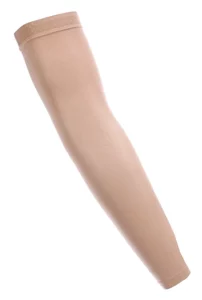Lymphedema is a progressive disease that causes pain and significant swelling in one arm or leg, which can have a great effect on a patient’s quality of life and ability to complete everyday tasks. The disease is caused by a blockage or damage to the lymphatic system that keeps toxic lymphatic fluid from circulating and draining properly.
Though there is technically no cure for lymphedema, surgery and conservative therapies can result in drastic improvements in swelling and pain management. One such conservative therapy is the use of lymphedema wraps and sleeves. When used properly, these compression garments can help maintain a normal limb size and volume post-surgery or before swelling has become too significant.
What are lymphedema wraps?
Lymphedema wraps are short stretch bandages that look similar to ACE bandages. ACE bandages stretch easily and have a high resting pressure, lymphedema bandages only stretch a small amount and have a low resting pressure and high working pressure. This essentially means that when a patient contracts their muscles, the short stretch bandage functions like a valve, ensuring lymphatic fluid can move up and out of the limb. These bandages are often used to safely address the excessive swelling in lymphedema patients without decreasing circulation or lymphatic drainage.
How are lymphedema wraps used?
Though lymphedema bandages can be used at any time, they are most commonly used during the acute phase of treatment. The bandages come in a variety of widths and lengths and patients typically have two sets of bandages — one that they wear and one that they wash. When used consistently, these short stretch lymphedema bandages can be very effective in keeping swelling at bay and continue to be the gold standard for conservative therapy.
It’s important to note that lymphedema wraps should be applied by a certified lymphedema therapist (CLT) who is knowledgeable in the safe application of these bandages. The CLT will layer rolls of short stretch bandages, gradually applying the appropriate pressure to treat the excess volume present in the limb to maximize results.
These wraps are used for as long as the patient has excess volume in their arm or leg, and they should be replaced every four months.
What are lymphedema sleeves?
Similar to lymphedema wraps, lymphedema sleeves are compression garments patients wear on their arms or legs to contain swelling. However, unlike compression wraps, sleeves are only used after the patient has gone through complete decongestive therapy (CDT).
When used daily as instructed, lymphedema garments can be very effective in treating arm or leg swelling. They can even reverse swelling and allow patients to maintain a normal, arm or leg volume that matches their unaffected limb.
Similar to lymphedema wraps, garments need to be replaced every four to five months. If used beyond four or five months, they become less effective and there’s no guarantee of containment. Every four months, the patient will be measured again to ensure the appropriate fit and compression gradient. Lymphedema garments typically come in four compression classes: 15-20 mmHg (class 1), 20-30 mmHg (class 2), 30-40 mmHg (class 3) and 40-50 mmHg (class 4). So it’s essential that patients are fitted for garments with the appropriate pressure gradient and fit, and then replace those garments on a regular basis. A poorly fitting garment will not only fail to reduce swelling, but it could be responsible for causing more issues.

How lymphedema sleeves are used in CDT
Lymphedema garments are used in conjunction with CDT. The first phase of CDT is a four-part system that includes education in proper skin care, self-care, manual lymphatic drainage (MLD), compression bandaging and how to exercise while in the bandages. The second phase is the maintenance phase which consists of the patient wearing compression garments instead of bandages, continuing to address skin care, performing self-MLD and exercising, which has shown to have a significant impact on keeping the affected limb stable.
Learn more about lymphedema and the treatment options available at the Granzow Lymphedema and Lipedema Center, including the Granzow Suction Assisted Protein Lipectomy SM .And read through our client success stories to see how lymphedema compression garments, surgery and conservative therapies can help you achieve the results you desire.